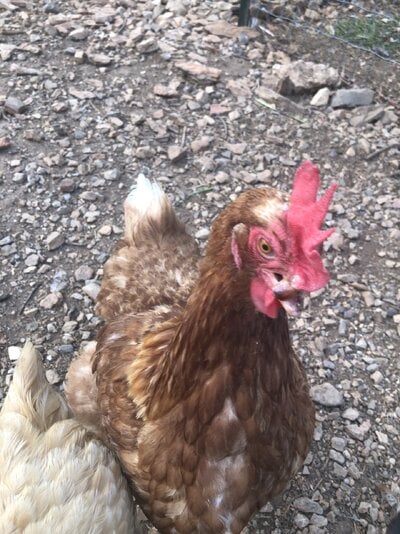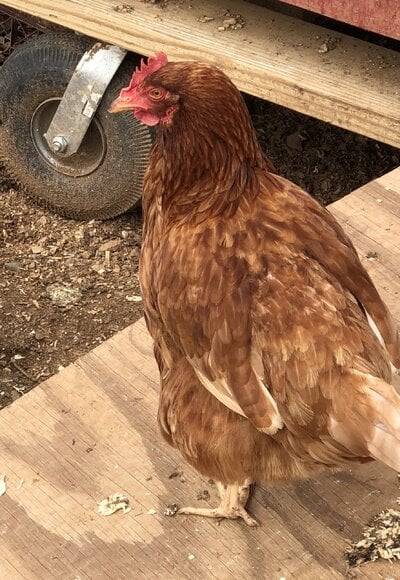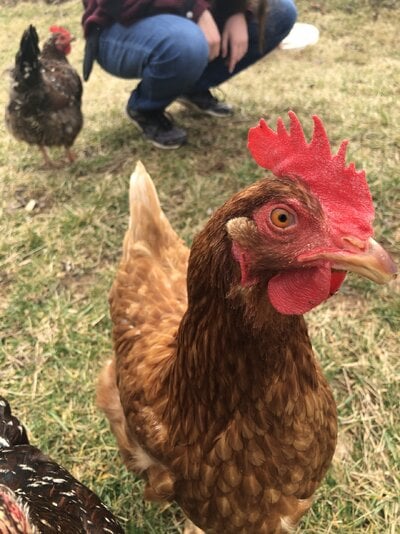Hi all!
I have noticed there is not very much info out there about the Hyline brown, so I thought I might write about my experience with them.
Before I start: I want to clarify one thing. The Hyline Brown is another version of the Red Sex-link. A Red Sex-link is created from crossing any white female chicken with a red male chicken. (Eg. Rhode Island Red male, White Plymouth Rock female.)
This creates a hybrid.
The benefit of creating a sex-link is that the chicks are easier to sex. The female chicks will always be red, and the males will always be white. This makes it easier for small farms because they don't have to hire anyone special in order to advertise that they sell sexed chicks. (They just have to make sure the employee isn't color blind, lol.)
Note: Breeding two Red Sex-links together will not give you the different color in male/female chicks as the first process would.
Many commercial companies sell their Red Sex-links under fancy names for advertising. (Eg. Golden Comets and Cinnamon Queens.) Some even just call them brown layers. The Hyline Brown is just another version of the Red Sex-link. Usually Red Sex-links are bred for high egg production, and are commonly used on organic and free-range farms. The egg's brown color makes them seem more natural than the white eggs usually sold at the grocery store.
Usually all Red Sex-links are generally the same, but someone could always breed two uncommonly mixed chickens, and therefore you might get less egg production from the strain than you expected. Most often they will specify if that is the case. (They may not even calling them a Sex-link, but a cross.) It is always good, though, to ask the breeder how many eggs their strain produces. The quality of the bird, such as health and genetics, will also vary from place to place. Make sure to buy your birds from a reputable hatchery.
When we bought them...
When we first got chickens, we wanted them to be good egglayers and not have to buy chicks. We also hoped to be able to have enough surplus eggs that we could sell them, and recoup the cost of the feed.
We looked for a place to get pullets, and for the right breed we wanted. Being in Southern Pennsylvania, this was not hard with Lancaster only an hour away. We had the choice to buy from Meyers, who sold Leghorns and Brown layers at 18wks old. They sold them for around $20 apiece, but we wanted something cheaper. We ended up finding a commercial farmer, and he sold us the 15 extra Hyline browns he had from an order of 2,000+ birds! We were able to get 16wk old birds for only $7.25 a piece. This was in 2021.
Attitude towards people
They were very quick to get used to us. These were my children's first "pets", so they spent a lot of time with them. We had them under a trampoline in the daytime to graze, because the run wasn't finished, and we hand-transported them to the coop every night. I think the time the children spent with them, and carrying them to bed every night, helped them warm up to us quickly. They started coming up to us by day 3. At day 4-5 we could hold them, and by the end of the week they were looking for us.
Integration, flock behavior
We introduced 4 Barred Plymouth Rocks to the group after the Browns had already been with each other for 2wks. The Rocks were only 12wks old. We got them from someone off of Craigslist for $15 each. We were hoping to use them for possibly brooding. (Although we never ended up with a rooster, so you can see how that ended.)
Being our first time integrating birds, even raising chickens at all, we tried putting them under the trampoline with the Browns a couple times, but each time the Browns mobbed them. The Rocks freaked out and got tangled in the netting. We had to pull them out. Thankfully, the Hyline's beaks were trimmed and they could do no more harm then look tough and pull some feathers out. We ended up storing the Rocks in the coop during the day, and put them in boxes at night, while the Browns were in the coop.
After 3 days of this, we finished the run, and put the Rocks in there while the others were under the trampoline on top the hill. The Browns looked down mournfully from the top of the hill, and wished they could take over the run to rule the entire chicken kingdom and put the pesky youngsters in their place. (It isn't called a pecking order for no reason!)
After a day of having the Rocks in the run, we put one of the Browns, the most skittish one, in with the Rocks. Poor thing was afraid even being close to them! We tried another, and she walked over and tried to peck Ebony, the Rock closest to her. Ebony, after being pecked once, gave the Brown a bit of a beating. Let's just say that the Brown kept her distance from then on.
Thus, Ebony defended the other Rocks for a week until they were integrated. They all remained close to each other and generally stood up for each other for about a month. I was very proud of Ebony. She ended up being our lead hen.
Egg Production
Around 18-20wks, we got our first egg.
Soon after, others started laying, and many of them layed double yolks for a month or two. The eggs went from pullet sized to large very quickly, some of them extra large or jumbo. I would say all of them started laying within 2wks of the first egg, and the eggs became full size after 2-4wks, because of the various egg-laying start dates.
I'd say about 25% of our birds lay jumbo/extra large eggs, and the rest lay large. The eggs have very good shape, and a nice color. The shade of brown is like the brown eggs you'd buy at the grocery store.
Our Plymouth Rocks lay medium eggs, and are often oblong in shape. After raising some other heritage breeds, such as Buff Orpingtons and Speckled Sussexes, I've realized that large eggs that become full size quickly are rare in breeds that are not commercial or hybrid.
For example, the Sussexes I raised from chicks. They started laying around the end of Sept. Now, at the end of December, most of them have finally gotten to full size - which is between medium and large. The majority lay medium.
The Sussexes, currently in their prime at 8mo, are laying every other day. My Hyline Browns, who are now 2yrs old (and should be taking a break to molt and because it's winter) are laying 5 out of 7 days in a week. When they were younger, even through their first winter, we were getting an egg a day from every one of them. The Rocks were producing 5 out of 7 like the Sussexes.
The Browns have laid fairly steady through both this winter and the last, only cutting production by half while molting, and then returning to normal. We used no artificial light, except for a heat lamp when it dropped below 20 degrees farenheit.
Weight and Breed Characteristics
Their weight varies widely. I have some birds who are very skinny, the size of a Leghorn, and some who are the size of a dual-purpose breed, like a Rhode Island Red. Their color is brown, with white splashes in it, especially on the back. None of their markings are the same, except that they all have a white tipped tail. They have a single comb, mostly large, and some even flopped over. They lay 300+ eggs a year. As far as the leg band size they take, I think I bought the 5/8 size. It was looser on some, but it was just right for the bigger girls. I was glad I hadn't gotten a smaller one.
Health
I wouldn't say they are the healthiest breed, and definitly not carefully bred and cared for during incubation.
My one bird, Gandalf, has a problem either caused by genetic issues or improper incubation called cross beak. (See pictures.) Another has crooked beak, which isn't as big a deal. With crooked beak, the beak does not line up perfectly. Instead, the top part of the beak is a little shifted to one side.
All of them have trimmed beaks, which make these problems minimal, except in the case of Gandalf. Gandalf is on the thinner side, and spends more time at the feeder. I feed them all layer pellet, and although she is obviously sustained by these, she sticks her head through the top of the feeder so she has deeper feed to peck at. She also has trouble free-ranging, and pretty much can't do it. She is quite protective of her feeder when she is eating. If she was shy, she might have problems. Otherwise she lays just as well as the other girls.
With this, I would personally not buy them as chicks, because the cross beak and crooked beak may require trimming and would likely increase the mortality rate. If their beaks were already trimmed, I would consider it. As pullets, they will have already gone through any problems they may encounter from it.
Remember: not all Red Sex-links are like this. These could have been a bad batch, and if not, than these problems are only because of the mistakes this particular company made. Buying them elsewhere would likely solve this problem completely.
Another problem we encountered was that 3 out of the 15 had a problem getting poop all in their bum feathers. Two of them had it bad enough that we gave them baths. The other's poop ball eventually fell off. I have not had that problem with my purebreds.
Also, they are not so great in rain. Their feathers are not as firm and waterproof as other breeds. The feathers are smaller and less dense. They remind me of Orpington feathers. In one of the picture attatchments below, you can see my Sussex next to Gandalf. Gandalf looks like she's been through a storm! If they have cover, they should be fine, but sometimes chickens decide they love showers in the cold. They are crazy!
Lastly, a note is that these birds are not bred for longevity, as most commercial farms cull their birds before their second winter, around 1.5yrs of age. Many times they won't live as long as other breeds because they put so much energy into producing so many eggs. They live about 4yrs, depending. (I have one girl who's thinking of quiting at 2yrs. *Sigh.* Thankfully she's started gaining back weight.) Other breeds can live 8+ yrs.
Update: I put Princess, the girl who was "thinking of quiting" on fermented feed, and now she is the healthiest of all my hens! Softest feathers, brightest comb! She has even started laying again!
Summary: Pros and Cons
| PROS | CONS |
|---|---|
| Large eggs early on, including jumbo and extra large size. | Genetic/breeding issues |
| Lay 300+ eggs per year. | A hybrid - if you are looking to breed, they won't be purebred |
| Lay steady through winter - even without artificial light. | Shorter lifespan than other breeds |
| Friendly and good with humans. | Not broody |
| Not broody | Varying weight; no guarenteed average weight |
| Easily sourced | Not very good in rain. Not very dense feathers to keep the water off. |
Thanks for reading!
Here's one of my girls celebrating the end of my lengthy interview of them.




